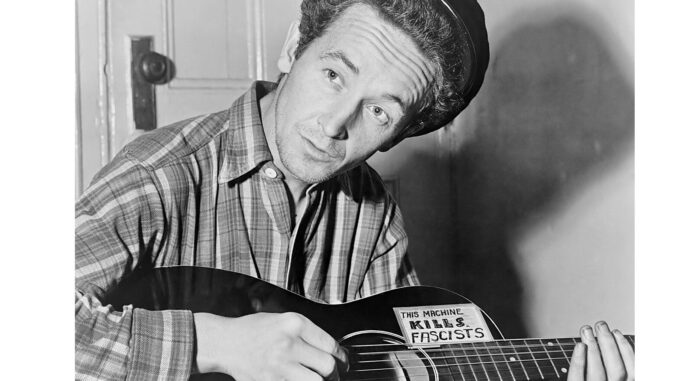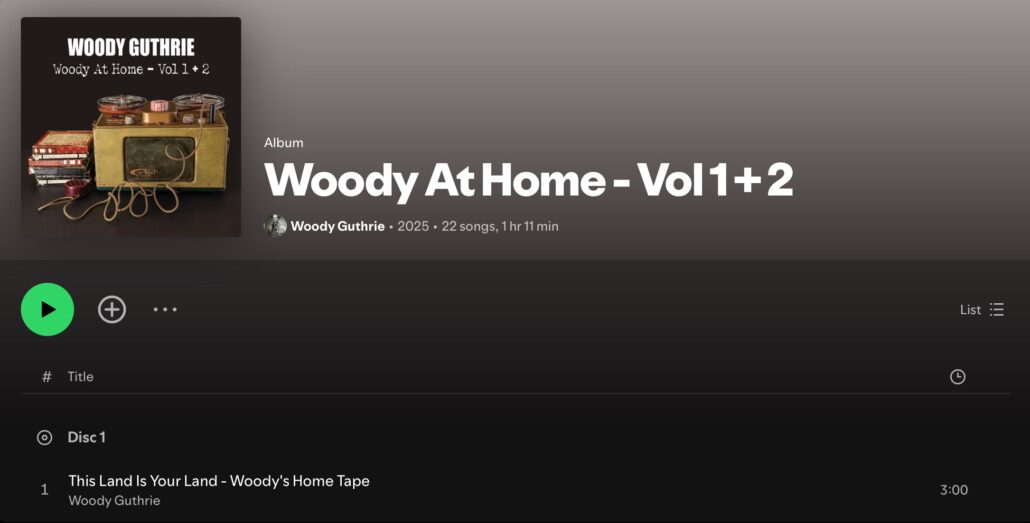
Woody Guthrie comes alive via Shamus Records, which has released a new double-LP “Woody At Home.”
The legendary Woody Guthrie’s last known recordings emerge after 75 years, with 22 previously unreleased tracks from 1951-1952 home tapes. Included in the unreleased 22 are rare “This Land is Your Land” verses.
The tracks are intimate recordings made at Guthrie’s Brooklyn apartment before Huntington’s disease silenced the folk legend forever. Check out the album link here.
“I just want to tell you fellers that I’m awful glad sending this batch of songs to you,” Guthrie said in audio found on these original home tapes. “This sounds like about the best tape I made so far… I was here at home watching the kids by myself. So the kids tapes I’m sending you, the ones with me and the kids on them, I don’t want you sending them back or anything like that. I just want you to keep them and play them, and see the place from whence all good folk songs breed and spring.”
On July 14, Woody’s only known recording of his original song “Deportee (Woody’s Home Tape)” was released as a single. “Deportee (Woody’s Home Tape),” (also known as “Plane Wreck at Los Gatos”) was originally written in 1948 in response to a New York Times article about a plane crash in Los Gatos Canyon, California that killed 32 people, including 28 migrant farm workers.
The Making of Woody At Home
Woody At Home was painstakingly brought back to life, using vintage Ampex tape machines and sophisticated de-mixing and restoration software. Woody’s voice and guitar are unchanged from what was on the original recordings. What has changed is the balance between them and the ambiance around them.
The producers made sure to keep in all the sounds of Woody’s family life, knocks at the door, and background sounds as part of the intimacy of the recording. There was no generative AI used in the restoration process. The restoration process simply allows us to hear Woody’s original performances without being clouded or obscured by hums or hisses.
Nearly 75 years after they were made, the recordings have been newly transferred and produced by Steve Rosenthal (The Rolling Stones, Blondie, Lou Reed, Natalie Merchant, Laura Nyro) and restored and mastered by Jessica Thompson (Kurt Vile, Erroll Garner, Mickey Newbury, Ralph Stanley, Lou Reed, Janis Ian).
“It has been my great pleasure to get to know and work with the Guthrie family for the past 25 years,” Rosenthal said. “With recent advancements in sound restoration technology along with the current political climate, I believe this is the right time to release Woody’s home tapes. These are not professional studio recordings, but instead, highlights from Woody’s audio sketchbooks.”
Co-producer and liner note writer Ostien says, “This is 100 percent Woody. Raw and clear. For the first time ever. And it’s brilliant.” The new set was produced by Anna Canoni, Kathy Ostien, and Steve Rosenthal.
Stream ‘I’m a Child Ta Fight’ here:
Woody Guthrie’s Original Recordings
These raw and intimate home tapes were recorded in the early months of 1951 and 1952, at the family’s apartment in Beach Haven, Brooklyn. Woody made them as his musical introduction to his publisher. Woody got his first publishing deal in 1950 with a new startup, TRO, founded by music publisher Howie Richmond.
TRO Essex founder Howie Richmond said, “Woody was writing songs about the struggles of ordinary people faced with hard luck and tough times. He touched every subject fearlessly and honestly and gave hope to those in greatest need… Woody was a hero to me before I ever met him and before I was a publisher… My goal was to hear everything he wanted to play. It was love and joy for me, from my heart.”
By 1950, two-channel tape recorders allowing recordings in stereo appeared in the United States for the first time. Able to get his hands on one, Howie sent the recorder to Woody in Brooklyn. Woody spoke, rambled, sang, and gave new context and intimate reflections into his songs using the single mic reel-to-reel machine. Woody sings about historic events, stories of the disenfranchised and ignored, love, and of course, the fight against fascism.
Thirty-eight-year old Woody Guthrie recorded these songs himself into one microphone on a reel-to-reel tape machine at the Guthrie family’s two-bedroom apartment, located at 49 Murdock Court, in the Beach Haven apartment complex, Brooklyn, NY in the early months of 1951 and 1952. The tracks include sounds of Woody’s then-toddlers as well as doors opening.
His last of the home tapes—the last Woody Guthrie recordings made—were sent to TRO in December 1952. In total, 32 tapes and more than 300 recordings of Woody at home were submitted.
Anna Canoni, Woody’s granddaughter and President of Woody Guthrie Publications, adds: “What I love about this project is that my grandfather is closer than he has ever been; it’s like I’m sitting in the same room with him, listening to him work through a song. Woody is rough and raw. It’s like we pulled back the curtain and get to hear his process. Songs about love, loss, racism, injustice, fascism, and greed. It’s all in there, just sit back and listen. As my grandfather once wrote, “I’ll use a song and my guitar to tell the things that are right and the things that are wrong.””
“Woody is just Woody,” John Steinbeck wrote, continuing, “Thousands know him by no other name. He is a voice with a guitar. He sings the songs of a people and I suspect that he is, in a way, that people. Harsh voiced and nasal, his guitar hanging like a tire iron on a rusty rim, there is nothing sweet about Woody, and there is nothing sweet about the songs he sings. But there is something more important for those who will listen. There is the will of a people to endure and fight against oppression. I think we call this the American spirit.”
Listen to ‘Woody At Home’ here:

